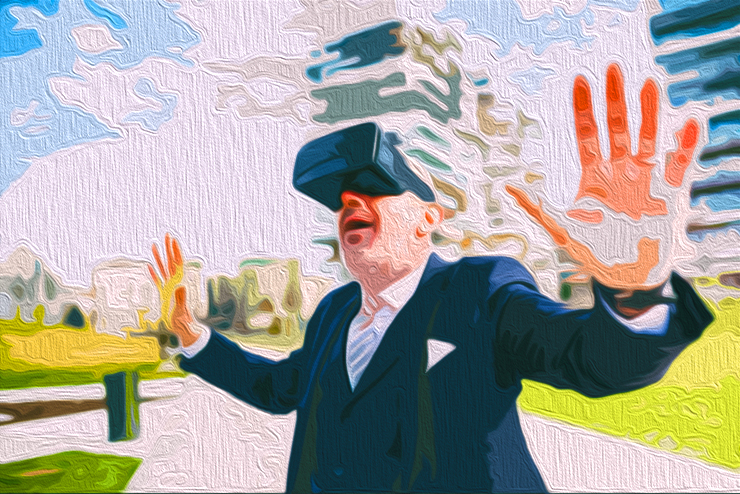
Hey there! If you've been noticing a shift in how social media impacts web traffic, you're definitely not alone. The relationship between social platforms and content creators has taken a significant turn, leading to a global reevaluation of marketing strategies.
Embracing the Evolution of Referral Sources
Recent data highlights a noticeable decline in social media referrals to external sites. Major players like The New York Times and The Guardian have experienced a dramatic drop of over 60% in social media referrals. This trend isn't limited to news outlets; it's affecting consumer brands too, with a median decrease of 19.6% in organic social media referrals.
Deciphering the Decline
Delving into the reasons behind this downward trend can offer valuable insights into the transforming digital landscape.
Factors Influencing the Paradigm Shift
Several factors contribute to this shift. Algorithm updates and policy modifications on platforms like Facebook have reshaped content visibility and sharing dynamics. Additionally, changes in user behavior, such as the emergence of platforms like TikTok that discourage external links, are influencing this transition.
Aligning with User Preferences
Grasping the driving forces behind user engagement is crucial to staying pertinent in the ever-evolving realm of social media.
Revamping Content Strategies
Content marketers must reconsider their reliance on social media for traffic. Adapting to these evolving landscapes is imperative, as methods that previously succeeded may now lack efficacy.
Innovating Traffic Channels
Exploring alternative pathways to reach audiences can unveil fresh opportunities for expansion.
Rethinking Social Media Investments
Research indicates that social media typically contributes less than 2% to website traffic on average. This disparity raises concerns about the alignment of social media investments with actual returns, compelling businesses to explore new avenues for audience engagement.
Exploring Return on Investment (ROI) Opportunities
Evaluating the returns from social media endeavors can guide strategic decision-making for future marketing ventures.
Enhancing Social Media Utilization Strategically
Optimizing social media strategies is vital for maximizing reach and engagement. Leveraging automation tools, diversifying content types, and investing in paid promotions can foster growth and interaction.
Elevating User Experience
Crafting a seamless user journey across social platforms can amplify brand visibility and user engagement.
Elevating Owned Content Channels
Given the diminishing role of social media in driving web traffic, focusing on owned channels like websites and email newsletters is paramount. These channels offer a direct line of communication with the audience, nurturing meaningful interactions.
Fostering Audience Relationships
Cultivating a loyal audience through owned channels can cultivate long-term brand loyalty and advocacy.
Streamlining Content Creation Processes
Delegating content creation to professionals can streamline the production process and ensure high-quality, tailored content. This approach can lead to cost savings and increased lead generation compared to traditional marketing methods.
Maximizing Content Impact
Investing in top-notch content creation can set businesses apart in a crowded digital landscape, effectively attracting and retaining audiences.
Adapting to Dynamic Platforms and Preferences
Remaining informed about social media platform shifts and audience preferences is pivotal for content marketers. By leveraging data insights, maintaining agility, and engaging with evolving audiences, businesses can stay ahead of the curve.
Prioritizing Flexibility
Flexibility and adaptability are indispensable traits for thriving in the ever-evolving digital ecosystem.
Championing Quality Content and Paid Strategies
Producing exceptional content and employing targeted paid promotions are increasingly crucial in content marketing. By combining top-tier content with strategic paid campaigns, brands can drive substantial growth and engagement.
Fostering Audience Engagement
Engaging with audiences through compelling content and targeted promotions can yield tangible results in brand visibility and audience interaction.
Embracing a Quality-Driven Approach
The evolving landscape of social media as a traffic source necessitates a shift in content marketing strategies. Prioritizing quality content, adapting to platform evolutions, and integrating paid strategies are pivotal steps in navigating this new terrain.
Putting Audience Value First
Centering content creation around audience needs can fuel sustainable growth and brand success in the digital realm.
Frequently Asked Questions
Why is defining your brand crucial?
A brand embodies the promise your company makes to its clients. It signifies specific qualities and benefits that differentiate your company from competitors. Your brand serves as a beacon of trust and credibility, instantly recognizable to potential customers.
Your brand mirrors your company's ethos, instilling passion in your employees when aligned with your products or services. It's not merely words or images; it's a commitment to delivering value consistently.
When crafting your brand, consider a name that clearly reflects your offerings, accompanied by a cohesive visual identity. Ensure your brand resonates with your target market, portraying traits like friendliness, trustworthiness, and expertise.
These considerations lay the foundation for a strong brand identity.
Which are the best digital marketing strategies you can implement remotely?
Digital marketing presents an excellent opportunity to reach customers spending extensive periods online and generate leads vital for business growth. Leveraging social media platforms like Facebook, Twitter, and LinkedIn, along with email marketing tools, can effectively promote your brand to prospects and clients.
Exploring various digital marketing avenues enables you to effectively showcase your products or services, engaging with your target audience regardless of your physical location. Mastering these channels can kickstart your digital marketing journey efficiently.
What distinguishes marketing from advertising?
Advertising is a communication form that promotes products or brands, often accompanied by a call to action. In contrast, marketing is a broader approach focused on conveying your company's mission, vision, and values to potential customers.
Marketing aims to establish relationships with both current customers and prospects, narrating your company's story, values, and commitment to excellence. While marketing revolves around storytelling, advertising primarily focuses on driving sales.
What are some examples of indirect marketing tactics?
Indirect marketing tactics involve methods that subtly promote your business. Initiatives like social media campaigns encouraging user-generated content, local newspaper advertisements directing customers to your business, or distributing coupons via email constitute effective indirect marketing strategies.
Indirect marketing is a cost-effective approach that fosters trust over time, demanding patience to yield results. Monitoring campaign effectiveness through metrics like lead generation allows you to refine your strategies for optimal outcomes.
How should I budget for my inaugural digital marketing campaign?
The budget for your initial digital marketing campaign varies based on your intended strategies. An entry-level campaign may cost between $50 and $100, encompassing expenses like search engine ad space, banner ad placements, and freelancer fees for design work.
Tracking campaign performance through analytics tools or manual methods enables you to gauge the success of your initiatives, facilitating adjustments for enhanced outcomes. Experimenting with different approaches until you discover the most effective strategy tailored to your business is key.
What are the 7 steps of an internet marketing strategy?
Internet marketing strategies leverage online media to achieve business objectives effectively. The seven fundamental steps include planning and research, implementation, monitoring and analysis, optimization, and evaluation. Regular execution of these steps is vital for a successful internet marketing approach.
- Planning – Identify your target audience and devise a plan to reach them, considering their needs and preferences.
- Implementation – Choose platforms, set up ads, and decide on advertising mechanisms like pay-per-click.
- Monitoring – Utilize analytics tools like Google Analytics to track traffic, conversions, and customer demographics.
- Optimization – Enhance your website to attract more visitors by improving features and navigation.
- Evaluation – Assess campaign performance, identify areas for improvement, and reevaluate to achieve your goals.
Statistics
- Between 2020 and 2022, digital marketing is projected to grow by 36%, claiming 54% of marketing budgets! (Source)
- A recent survey found that 14% of older Gen Z consumers made a purchase based on an influencer's recommendation in the past six months. (Source)
- Experts suggest sharing 20% promotional content and 80% valuable content to engage effectively. (Source)
- In 2017, 34% of marketers considered co-branding as the most effective method to boost email subscribers. (Source)
- Delivering CPCs 80% below average and CTRs 4-5 times higher than average for enhanced performance. (Source)
External Links
How To
What's your marketing strategy?
Ever heard the saying "If you build it, they will come"? Well, that's a misconception. Building something is just the start; attracting customers requires implementing Internet Marketing Principles to reach your target audience effectively and grow your business.
Internet Marketing Principles serve as guidelines for marketers to create websites, blogs, and email campaigns that generate leads or sales. Let's take a look at marketing handmade jewelry online as an example.
These are just a few examples of Internet Marketing Principles that can propel your brand forward.
Frequently Asked Questions
What are the primary types of marketing you use?
Marketing is the act or communication of ideas, values and messages to consumers. We often use the term marketing interchangeably with advertising. Marketing does not just include advertising. Marketing covers all communications that promote and market products or services.
Three key components of marketing are branding, promotion and distribution. The company's brand is how it identifies with its target audience. Promotion is the act or obtaining attention for your brand using paid advertisements, promotional materials, and public relations. Distribution is the delivery of your message to your target audiences. This can be done by traditional methods, such as radio, print and email. However, modern technologies make it more accessible.
What are the 7 steps of internet marketing strategy?
Internet marketing strategies allow businesses to achieve their business goals by using online media. The seven main steps include planning and research, implementation, monitoring as well as analysis, optimization and evaluation. Each step is crucial for internet marketing success and should be done regularly.
- Planning – This step involves identifying your target audience and developing a plan for how you want to reach them. Consider the product or services you offer, as well as who might be interested.
- You can use research to understand the needs and interests of your customers so that you can choose the products or services that best meet their needs. It provides valuable insight into consumer behavior, trends, and other information.
- Implementation includes choosing a platform (e.g., Facebook) and determining where to place your ads. Once you have selected your platforms, make sure that they are correctly set up. Decide whether to spend money on advertising or pay per-click.
- Monitoring – This allows you to monitor your efforts and determine if they are succeeding. Google Analytics is an analytics tool that tracks traffic flows, conversion rates, customer demographics, and other metrics.
- This analysis will allow you to compare your results with benchmarks and past performance levels. This step allows you to determine where your areas are weak and how to improve them.
- Optimization – Making changes to your website in order to attract more visitors is called optimization. You can add new features or alter how users navigate through your site.
- Evaluation – Evaluating your progress lets you see how well your campaign performs. Are there areas that could be improved? If not then you may not have met your goal. If there are still problems that need to be addressed, you will need to reevaluate.
What is the difference of advertising and marketing?
Advertising is communication that promotes brands or products. Advertising often includes a call to action such as “Buy Now!” or “Click here.”
On the other hand, marketing is a way of communicating your company's mission, vision, and values to potential customers. Marketing is also a way to establish relationships with potential customers and current customers.
Online sales of shoes can be a great example of marketing. You may use marketing to tell a story about you and what you have to offer. You might talk about your background, philosophy, or commitment to quality. You could also share testimonials from customers who are satisfied with your products. For people to come to your website, you could offer them a free pair of shoes.
Marketing is simply telling stories. Advertising is about selling products.
Statistics
- According to statistics, 60% of online shoppers worldwide actively search for coupons before purchasing from a virtual shop. (influencermarketinghub.com)
- Meanwhile, a PartnerPath poll found that co-marketed ads help 68% of consumers arrive at a buying decision before even speaking to a salesperson. (influencermarketinghub.com)
- From 2020 to 2022, eMarketer predicts that digital marketing will grow by 36% and take up 54% of marketing budgets! (marketinginsidergroup.com)
- 81% of brands employ affiliate marketing, and eCommerce sites are particularly good candidates. (blog.hubspot.com)
- Many experts recommend you share 20% of your promotional content and 80% of other valuable content you find. (marketinginsidergroup.com)
External Links
blog.hubspot.com
moz.com
- SEO Learning Center, Moz
- [Case study] How we ranked #1 in a high-volume keyword in under 3 months – Moz
youtube.com
statista.com
How To
Online Marketing Tips and Techniques from the Top Brands
It's important to ensure your audience is able to understand the content you are creating for online marketing. If your audience doesn't care about your product or service, why would they care about your blog posts?
Your website should be focused on fashion accessories. Not general web design tips.
You can promote your business by using social media platforms such LinkedIn, Twitter, Facebook, LinkedIn and Instagram. Social media sites allow businesses to share information and interact with customers.
Social media sites also provide a great opportunity to connect with existing and potential clients.
Create content that engages users and encourages them to share content with their friends. Shared content increases your site's visibility and traffic.
You can keep your content fresh and updated by posting regular updates. Posting once a month or more is better than posting daily.
Posted content usually receives more engagement because readers expect to see new content.
You can include links in your content that link back to your homepage. This makes it easier for your visitors to find additional resources.
Mobile-friendly content is essential. Mobile devices now outnumber desktop computers. According to a recent survey, more than 50% of internet users access websites via their smartphones.
You can test your content on different smartphones and tablets to make sure it looks great on smaller screens. The mobile-first approach is a must-have for website developers and owners.
It's not just about aesthetics, either. Mobile sites are more likely to convert better than desktop websites. Not only are they easier to navigate, but they also tend to load faster because of the smaller size of the site.
You should create content that is meaningful to your audience.
————————————————————————————————————————————–
By: 8068
Title: The Ultimate Guide to Navigating the Dynamic Social Media Landscape for Enhanced Web Traffic
Sourced From: internetlib.org/the-future-of-web-traffic-navigating-the-changing-social-media-landscape/
Published Date: 5/7/2025 5:08:19 PM

